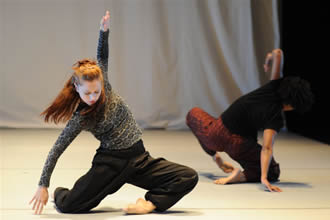The Elias String Quartet’s third concert in Brendle Recital Hall on the campus of Wake Forest University this week completed the first half of a series of six concerts dedicated to the complete quartets of Ludwig van Beethoven. Part II will begin on October 21 and end on October 24, as part of the celebration of Beethoven’s 250th birthday. The Elias Quartet (the name is derived from the German name for “Elijah”) is composed of four musicians who came together in 1998 in Northern England – French sisters Sara and Marie Bitloch, violin and cello, respectively, Dutch violist Simone van der Giessen, and Scottish violinist Donald Grant. Sara Bitloch is currently on maternity leave and was replaced by the very fine British violinist Benjamin Nabarro.
Choosing a format for each concert that allows the audience to experience Beethoven’s progression from early composition through his middle period and culminating in the sublime and rarified late quartets, the musicians thrilled the large and totally quiet audience. Indeed, we sat up and leaned forward so as not to miss a nuance or a pizzicato. The balance was perfect, and the interchange of phrases moving from one musician to the next was so clean that I came to the conclusion that they were thinking with each other’s brains. Constantly watching each other, commenting musically, in perfect synchronicity, truly four minds melded into one super-human existence for the duration of the piece.
The early Quartet in A, Op. 18, No. 5, was charming and smooth, with contrasting accents and much florid triplet writing. Op. 59, No. 3, started with a shocking diminished chord, unusual use of pizzicato in the cello in the second movement and ended with a speeding moto perpetuo. The highlight of the evening for me was the late Quartet in C-sharp minor, Op. 131, a work of seven linked movements, a voyage in discovery, with ample use of the oratorical recitative, outbursts, cadenzas and the dotted rhythm which seemed to obsess Beethoven in his later years. This was glorious playing, again with scrupulous attention to detail and tremendous contrasts.
Why the “string quartet?” And why a series of six concerts dedicated to the complete quartets of Beethoven? These questions acknowledge the importance of the physical entity of four musicians – two violinists, a violist and a cellist – as well as the genre which evolved thanks to the efforts of three great composers who lived during the Age of Enlightenment: Franz Josef Haydn, Wolfgang Amadeus Mozart and Beethoven. This is pure sound of a homogenous nature, untainted by winds, percussion or facile effects.
Speaking in generalities, for centuries music was composed to glorify the church. And as church and state separated, composers wrote more under the patronage of the aristocracy, dedicating works to wealthy patrons. Eventually, as the monarchy declined and democracy rose from its ashes, the Romantic era composers composed for themselves, following and inventing their own musical rules.
In many ways, the evolution of the string quartet, as a formal musical genre, parallels this historical rise of the heroic composer. By the time Haydn had written some 30 quartets, he had transformed the quartet from a tune with accompaniment to a genuine dialogue between four equally engaged musical voices. Mozart (26 quartets) and Haydn (over 65 quartets) dedicated volumes of quartets to each other, while Beethoven waited until his late twenties to write his first quartet, finally completing 17 of them. With Beethoven, the quartet developed into a lofty intellectual voyage where for 45 minutes the four players interact with each other in mindful attention to details unique to that particular work.
Beethoven’s quartets were composed in clusters at varying parts of his 56-year life and became more personal and eclectic as the composer matured. A friend once commented that Beethoven’s works are like “garments sewn with white thread,” meaning that internal sections are easy to distinguish from each other because the transitions are often abrupt, especially in the late quartets.
After several standing ovations, we were released from Beethoven by Grant’s lovely arrangement of a traditional Scottish air, “Da Day Dawn,” followed by “Calun’s Road” by Donald Slaw. The entire evening was prefaced by Professor David Levy‘s excellent lecture, illustrated and enlivened by many musical examples and delivered in the WFU Chorus room, across the foyer of Brendle Hall.











